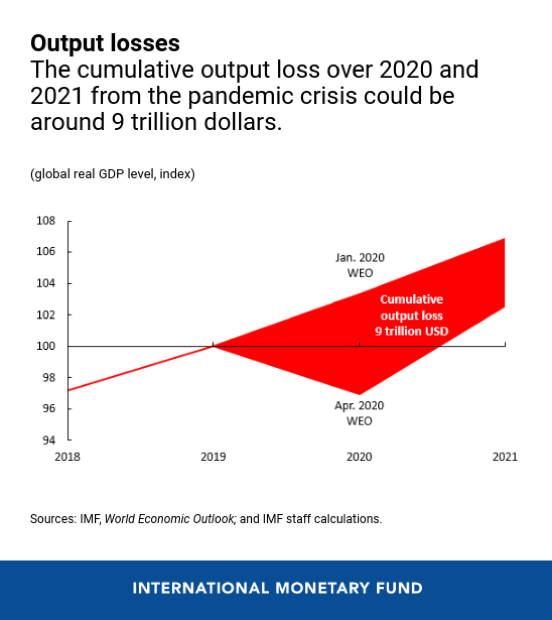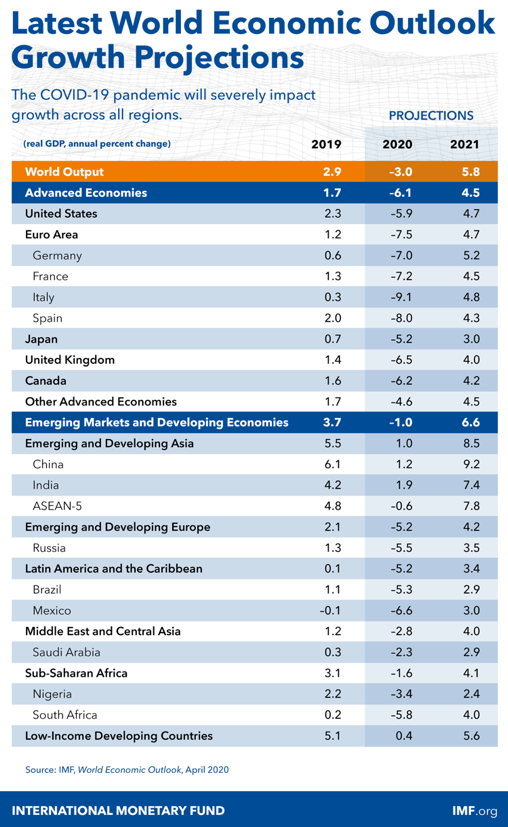
Published on April 15, 2020 / Leer en español
Five things you should know today
1) IMF forecasts the worst recession since the Great Depression
The latest update from the International Monetary Fund (IMF) warns that the world economy is facing the worst recession since the Great Depression. This massive slowdown in economic activity is obviously due (and rightly so) to the impact of shelter-in-place and quarantine measures imposed by countries around the globe.
As Gita Gopinath, Director of the IMF’s Research Division, writes “the magnitude and speed of collapse in activity that has followed is unlike anything experienced in our lifetimes.” Working under the assumption that “the pandemic and required containment peaks in the second quarter for most countries in the world, and recedes in the second half of this year”, the IMF forecasts:
- A decline of 3% in global GDP during 2020;
- Global growth in 2021 to rebound to 5.8 percent, if “the pandemic fades in the second half of 2020 and policy actions taken around the world are effective in preventing widespread firm bankruptcies, extended job losses, and system-wide financial strains”;
- The rebound in 2021 will be “only partial as the level of economic activity is projected to remain below the level projected for 2021, before the virus hit”; and
- The cumulative loss to global GDP over 2020 and 2021 “from the pandemic crisis could be around 9 trillion dollars, greater than the economies of Japan and Germany, combined.” (See chart below)

Furthermore, this is the first time since the Great Depression that both advanced and emerging economies are in a recession at the same time. According to the international financial watchdog, economies dependent on tourism, travel, hospitality, and entertainment for their growth have been particularly hard hit.
The chart below summarizes the IMF’s forecast by region:

2) “Suppress and lift”: The strategy in Hong Kong and Singapore
Hong Kong and Singapore have established remarkably similar strategies to contain the spread of the SARS-CoV-2 virus in their respective jurisdictions. According to a recently published article in Science magazine, both places saw significant spikes in cases earlier this year. In response, they:
- Ramped up testing, with “Singapore doing roughly 12,800 tests per million population; while Hong Kong has done 13,800 per million”;
- hospitalized those who test positive, regardless of whether they have symptoms, to prevent them from infecting others; and
- do extensive contact tracing: “in Hong Kong, quarantined people are fitted with electronic wristbands that work with smartphones to track their whereabouts”; while “in Singapore, they must respond to mobile phone text messages that reveal their location several times a day. Violators face fines and jail terms.” It is not clear to us that this strategy can be successfully implemented in the United States due to potential constitutional constraints, lack of state capabilities, and limitations on public health resources.
3) COVID-19 pandemic poses risks to global food supply chain
Representatives from the food industry as well as from the United Nations have warned about potential food shortages due to the COVID-19 pandemic. The disease has impacted all segments of the food industry as farmers have been forced to destroy crops due to reduced demand from hotels, restaurants, and public schools; some large-scale producers have been forced to close down processing plants due to viral outbreaks among their employees; and grocery stores have seen orders cancelled as suppliers divert products to larger markets or higher paying clients.
To be clear, this does not mean we will see empty supermarket shelves tomorrow. Rather, there is a real risk of shortages depending on how long the pandemic lasts and how fast the largest players in the food industry can rearrange their global supply chains. Just something to keep an eye on.
4) President Trump claims he has “total authority” to lift restrictions related to the pandemic
As if the decision to lift shelter in place and quarantine orders weren’t complicated enough, President Trump has decided to pick a constitutional fight with state governors by claiming he has “total authority” to lift such controls. His broad claim of presidential power comes on the heels of an announcement made by two groups of governors to coordinate the reopening of their respective regional economies.
Governors from Connecticut, Delaware, Massachusetts, New Jersey, New York, Pennsylvania, and Rhode Island “agreed to create a committee of public health officials, economic development officials and their chiefs of staff.” While the governors of California, Oregon, and Washington “also announced Monday a joint approach to reopening economies that they called a Western States Pact.”
In addition to the prospect of creating a constitutional crisis in the midst of the worst public health emergency in a century by disregarding more than 200 years of constitutional analysis, jurisprudence, and scholarship, the president will also make life extremely difficult for business owners as “conflicting orders by Washington and state capitals would leave businesses and workers in the untenable position of trying to decide which level of government to listen to when it comes to reopening doors and returning to their jobs.” We can only hope the president reconsiders his baseless and unreasonable position before more damage is done to the economy.
5) A demographic profile of workers in frontline industries
One of the bitter ironies of this pandemic is that many workers who were usually invisible to many people—store clerks, bus drivers, warehouse workers, cleaners, among others—have suddenly become “essential” during this crisis. The Center for Economic and Policy Research (CEPR) has recently published a demographic profile of these workers. Among their conclusions we find the following:
- “Workers in frontline industries are disproportionately women;
- People of color are overrepresented in many occupations within frontline industries;
- Immigrants are overrepresented in Building Cleaning Services and in many frontline occupations in other frontline industries;
- Many workers in frontline industries are over age 50, and a substantial number live in a household with one or more older people; and
- More than one-third of workers in many frontline industries live in low-income families.”
In addition, many of these workers don’t earn a living wage and don’t have health insurance or paid sick leave. Yet they put their lives at risk every day so the rest of us can work from home. That’s why when this crisis is over, we will need to revise some of the basic covenants of our social contract.
Quote of the Day
“Facts do not cease to exist because they are ignored.”
—Aldous Huxley
Note from the editor
Total authority. Any seventh-grader with a half-way decent understanding of American history could tell you there is no such thing in the Constitution of the United States. The drafters of the Constitution argued for days on end to make sure that was the case. Even Alexander Hamilton, who among the framers consistently argued for a strong, centralized executive, disagreed with the concept of “total authority.” No need to relitigate that history here.
Yet that is what President Trump has just claimed for himself, setting off a constitutional dumpster fire in the middle of a worldwide health crisis. More than half a million cases, over twenty thousand deaths, and that is in the United States alone. Yet this man cannot manage to find within himself a minimum degree of empathy for the anxious, the scared, the grieving families of the United States. Is it really so hard for this man to show some basic human decency? To care for others, be kind, help heal the wounded, offer comfort the suffering? God help us, if that is the case.
This is the end of today’s briefing.
Stay safe and well informed!
